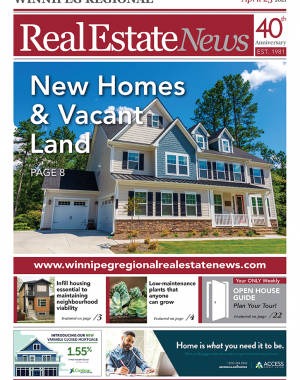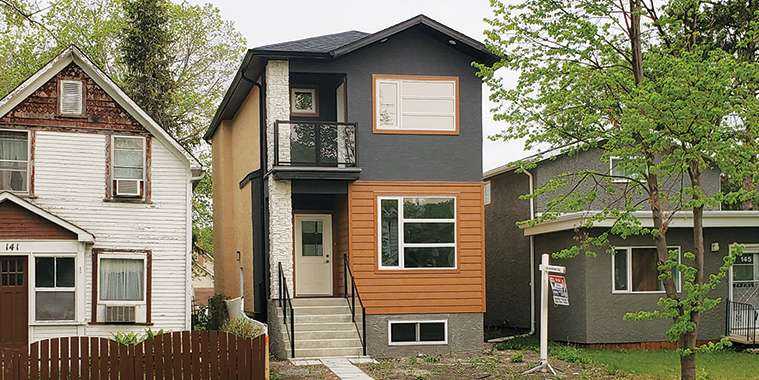By Peter Squire
Infill housing is essential. This should not come as a surprise since Winnipeg has some of the oldest housing stock in the country with 35% of dwellings built prior to 1960. The Winnipeg Regional Real Estate Board (WRREB) supports residential infill as an important step to help maintain the viability and renewal of our older neighbourhoods.
The City of Winnipeg Comprehensive Housing Needs Assessment Report — completed last year —
indicates that 8% of the city’s housing stock is in need of major repair. We know this percentage will be that much higher in relation to our mature communities which are the domain of many of these homes. Their median age is 73 years. As these older homes reach the end of their life cycle, they either need to be completely refurbished, if that’s even possible, or replaced if they’re no longer salvageable or adequate for what modern buyers are looking for in a home.
This report and essential housing data research contained therein is highlighted as one of the fundamental cornerstones of the Residential Infill Strategy Implementation. Deservedly so, since in the proposed and updated OurWinnipeg 2045 there is emphasis on investing in neighbourhood revitalization, evidence-based decision-making and environmental resilience — to name just a few — that directly relate to building sustainable neighbourhoods and taking advantage of the existing infrastructure and many services they already provide.
Part and parcel of OurWinnipeg 2045 is to make more efficient and better use of our existing infrastructure to ensure we are not only adhering to the City’s Climate Action Plan, but being fiscally responsible in managing the cost of operating an expanding network of roads and services.
The Complete Communities 2.0 — the City of Winnipeg’s detailed citywide secondary plan which sets out how we guide growth, development and land use — is recommending that 50% of new builds in the built-up area of the city be infill. This makes it abundantly clear that the City is committed to residential infill as an essential part of its future growth strategy. By 2040, Winnipeg is expected to grow by 160,000 people and require 82,000 new dwelling units.
So looking ahead to Winnipeg’s future, why should we put so much stock in getting residential infill right? We know for certain that unlimited greenfield expansion is not sustainable and we need to aggressively look for infill opportunities within the built-up area of the city. This includes mature communities where people want to live and enjoy the amenities and advantages they offer.
Winnipeg’s history has shown how neighbourhoods can destabilize when housing stock deteriorates and disinvestment in areas occur. House values drop and homeowners sell and move to a more desirable area to raise their family. More rentals emerge without the same care and investment being put in that neighbourhood’s housing stock, and the cycle of decline continues.
In the 1990s, house prices were in freefall in an MLS® area that encompasses east of Arlington Street between Portage Avenue and Notre Dame Avenue. Thanks to the intervention of a number of non-profit housing groups and other key housing stakeholders (e.g. Spence Neighbourhood Association), along with support from all three levels of government, slowly but surely a neighbourhood that was on the cusp of irretrievable decline was reversed. Many houses were either completely refurbished or removed and replaced with new infill homes sold to first-time homebuyers. These buyers were given an amazing opportunity to get into home ownership through non-profits such as the REALTOR®-led Housing Opportunity Partnership (HOP) and have been central to the neighbourhood’s housing improvement turnaround and a catalyst for other buyers to return to this area and reinvest in it.
From an average MLS® area single-family home sales price of $23,752 in 1999 to $37,951 four years later, and now seeing this MLS® area in 2020 at $177,469 — with a sales increase of 49% from the year before — these are metrics worth celebrating given where this area was heading 20 years ago.
So, as we move finally to support and approve a long awaited residential infill strategy this year, let’s focus on the big picture of what the city as a whole needs to do. Let’s not get caught up in finding all the reasons why we cannot embrace the good quality infill that has been created by responsible and well-meaning developers.
The two latest additions to the infill strategy which were not vetted by the Technical Advisory Committee, which WRREB served on, are contrary the direction of Complete Communities 2.0 and the need to support much needed infill in our city. They prevent subdivisions that back onto a gravel rear lane and duplexes and secondary suites from being developed on these sites. The other restriction limits the pace of infill construction to two sites per city block, per annum.
Housing supply is as critical as it always has been to meeting current demand and a growing city. We cannot afford to lose Winnipeg’s housing affordability advantage if we persist on putting up more roadblocks and making it more difficult for the home building industry to create infill. If we continue with the roadblocks, this industry will just focus all their attention on greenfield development (in or outside the city) while houses that need to be replaced will remain, doing nothing to help renew the streets and neighbourhoods they are situated in.
Peter Squire is the Winnipeg Regional Real Estate Board’s Vice-President, External Relations & Market
Intelligence.



